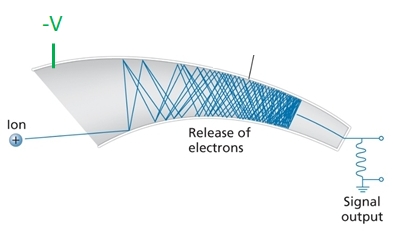16.4: Ion Detectors
- Page ID
- 272249
The simplest ion detector is the Faraday Cup Detector pictured in Figure 1. In this detector an ion beam strikes the inner metal surface and is neutralized by electrons. The small electron current is amplified and converted into a voltage. The electron current is proportional to the number of ions striking the surface. The Faraday Cup detector is akin to the vacuum phototube in that at most one electron flow for each ion striking the surface. Hence it is not a very sensitive ion detector.

Figure 1: A simple sketch of a Faraday cup detector and a picture of an actual one.
A more commonly encountered ion detector is the channeltron detector shown in Figure 2. In a channeltron an ion strikes the inner surface and produces a secondary electron. Because of the arrangement of the electrostatic potentials, the secondary electron is directed further into the channel where it strikes the inner surface again producing 1 -3 secondary electron. The process continues for each of the secondary electrons generated and the charge packet moves further towards the end of the channel. A channeltron is akin to a photomultipler tube but rather than a discrete dynode array a channeltron is a continuous dynode array. Like a photomultiplier tube a channeltron has gain. On average each ion striking the channeltron is converted into 107 or 108 electrons.

Figure 2: a illustration of a channeltron ion detector.
Another ion detector related to the channeltron is the microchannel plate (MCP) detector. A microchannel plate is a thin disc composed of many individual channeltrons. Each disc has a gain of about 103 and typically two plates are used in tandem to achieve a gain approaching that of a channeltron. MCPs are widely used in physics and physical chemistry to spatially detect the path of ions. MCPs are also in fast oscilloscopes to intensify images.

